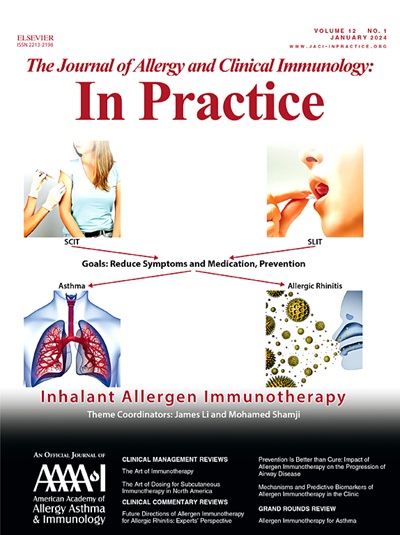小儿过敏患者肾上腺素鼻喷雾剂尼菲的药代动力学和药效学。
IF 8.2
1区 医学
Q1 ALLERGY
Journal of Allergy and Clinical Immunology-In Practice
Pub Date : 2025-06-01
DOI:10.1016/j.jaip.2025.03.019
引用次数: 0
摘要
背景:肾上腺素是治疗严重过敏反应(包括过敏反应)的金标准,通常通过肌肉注射给药。尽管肾上腺素的安全性和有效性得到了充分的证明,但患者可能对注射或接受注射犹豫不决,从而增加了并发症的风险。尼菲肾上腺素鼻喷雾剂的开发是为了提供一个额外的选择,可以减少剂量的犹豫。目的:本研究旨在描述尼菲在儿童受试者中的药代动力学和药效学特征,并比较儿童和成人受试者的药代动力学特征。方法:这是一项1期、多中心、单剂量、药代动力学/药效学研究。42名儿科患者根据体重给药1或2毫克尼菲。采用描述性统计方法总结药代动力学和药效学参数,并采用线性混合效应模型进行分析。结果:在儿童受试者中,neffy 1 mg导致的平均最大浓度略低于neffy 2 mg (651 vs 690 pg/mL),高于成人受试者的最大浓度(481 pg/mL)。虽然成人受试者在给药后表现出明显的收缩压升高,但在儿科患者中观察到的收缩压升高明显较低,并伴有舒张压的微小差异。对心率的影响在儿童和成人受试者中是相似的。结论:在儿童受试者中,1和2毫克剂量的尼菲均可产生安全有效的平均最大浓化值。注意到年龄相关的药效学反应差异;然而,这些差异可能归因于预期的年龄生理差异。本文章由计算机程序翻译,如有差异,请以英文原文为准。
Pharmacokinetics and Pharmacodynamics of neffy, Epinephrine Nasal Spray, in Pediatric Allergy Patients
Background
Epinephrine is the gold-standard treatment for severe allergic reactions, including anaphylaxis, and is typically administered via intramuscular injection. Despite epinephrine’s well-documented safety and efficacy, patients may be hesitant to administer/receive injections, thereby increasing the risk of complications. neffy epinephrine nasal spray was developed to provide an additional option that may reduce dosing hesitancy.
Objective
This study was conducted to characterize neffy’s pharmacokinetic and pharmacodynamic profiles in pediatric subjects, and to compare profiles between pediatric and adult subjects.
Methods
This was a phase 1, multicenter, single-dose, pharmacokinetic/pharmacodynamic study. Forty-two pediatric patients were dosed with 1 or 2 mg of neffy, based on weight. Pharmacokinetic and pharmacodynamic parameters were summarized with descriptive statistics and analyzed using a linear mixed effects model.
Results
In pediatric subjects, neffy 1 mg resulted in a slightly lower mean maximum concentrations relative to neffy 2 mg (651 vs 690 pg/mL), which were higher than the maximum concentrations in adult subjects (481 pg/mL). Although adult subjects demonstrated a marked postdose increase in systolic blood pressure, the systolic blood pressure increase observed in pediatric patients was significantly lower and was accompanied by minimal differences in diastolic blood pressure. The effect on heart rate was similar between both pediatric and adult subjects.
Conclusions
In pediatric subjects, both the 1 and 2 mg doses of neffy resulted in mean maximum concentration values that are expected to be both safe and efficacious. Age-related differences in pharmacodynamic responses were noted; however, these differences are likely attributable to expected age-based differences in physiology.
求助全文
通过发布文献求助,成功后即可免费获取论文全文。
去求助
来源期刊

Journal of Allergy and Clinical Immunology-In Practice
ALLERGYIMMUNOLOGY-IMMUNOLOGY
CiteScore
11.10
自引率
9.60%
发文量
683
审稿时长
50 days
期刊介绍:
JACI: In Practice is an official publication of the American Academy of Allergy, Asthma & Immunology (AAAAI). It is a companion title to The Journal of Allergy and Clinical Immunology, and it aims to provide timely clinical papers, case reports, and management recommendations to clinical allergists and other physicians dealing with allergic and immunologic diseases in their practice. The mission of JACI: In Practice is to offer valid and impactful information that supports evidence-based clinical decisions in the diagnosis and management of asthma, allergies, immunologic conditions, and related diseases.
This journal publishes articles on various conditions treated by allergist-immunologists, including food allergy, respiratory disorders (such as asthma, rhinitis, nasal polyps, sinusitis, cough, ABPA, and hypersensitivity pneumonitis), drug allergy, insect sting allergy, anaphylaxis, dermatologic disorders (such as atopic dermatitis, contact dermatitis, urticaria, angioedema, and HAE), immunodeficiency, autoinflammatory syndromes, eosinophilic disorders, and mast cell disorders.
The focus of the journal is on providing cutting-edge clinical information that practitioners can use in their everyday practice or to acquire new knowledge and skills for the benefit of their patients. However, mechanistic or translational studies without immediate or near future clinical relevance, as well as animal studies, are not within the scope of the journal.
 求助内容:
求助内容: 应助结果提醒方式:
应助结果提醒方式:


